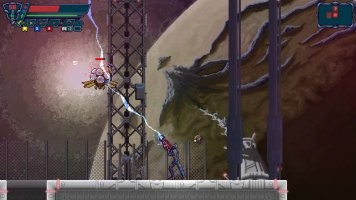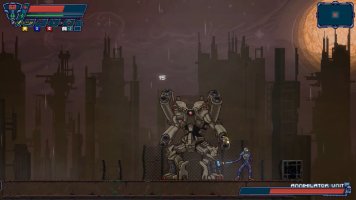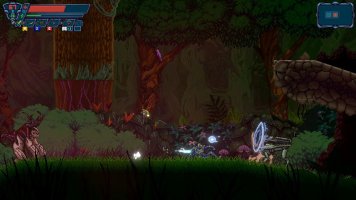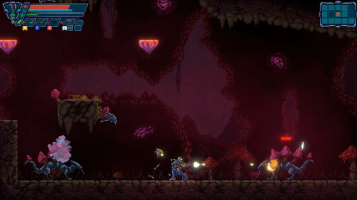General Information
Kamina Dimension self-published MindSeize on Steam in 2020. The plot follows M.C. (Mordred Chad Fox), a former investigator turned bounty hunter. His mission? To destroy "The Ascended," a sinister group that left him crippled and stole his daughter's mind. M.C. joins forces with a spaceship crew, remotely controlling their "Mag" robot via a neural link. The story, told mainly through dialogue boxes with comic-style cutscenes bookending the game, is a familiar tale of a grieving father's rescue mission. However, unlike games that use their art style to enhance the narrative tone (think Max Payne), MindSeize's visuals are basic, reminiscent of early 2000s web comics.
The game's overall presentation lacks memorable elements. The soundtrack fails to leave an impression, and the dialogue, while grammatically sound, often comes across as flat. However, the developers deserve credit for incorporating the protagonist's disability into the storyline. The main villain uses M.C.'s condition to argue for abandoning his organic body in favor of the Mag, which adds depth to the narrative. This aspect could have been explored further, as it barely qualifies as a theme in its current form. Despite these critiques, they don't significantly impact the game's core appeal: its fast-paced Metroidvania action, which proves to be quite enjoyable.
Combat in the game revolves around two main weapon types: melee and ranged. Players also unlock additional equipment, called mods, such as grenades, a flamethrower, and a close-range attack. Energy powers these mods and enables specific high-damage melee and ranged attacks. While the weapons are basic, they function well, feeling responsive and satisfying to use. Enemy types and designs, though not groundbreaking, serve their purpose with decent variety. This variety enhances the combat experience, particularly in how well the ranged and melee weapons complement each other.
As expected, ranged weapons offer safer but slower-paced combat, while melee weapons deal more damage at higher risk. Interestingly, the arc of most melee weapons while jumping is particularly satisfying. A well-executed jumping melee attack in a side-scroller can significantly improve one's opinion of the game (think Zero in Megaman X4), and MindSeize delivers on this front. The starting weapon, with its large, satisfying slashing arc, provides a small dopamine rush with each use. However, to perform the jumping attack, you first need to jump, which brings us to a noticeable issue with MindSeize's gameplay: the unconventional button mapping. For those using a PlayStation controller, the jump button is Circle, not Cross as one might expect.
This seemingly minor detail becomes increasingly frustrating as you progress through the game. In my initial hour, I struggled to dodge attacks or execute the aerial slash, often getting hit instead. Typically, in side-scrollers, players rest their thumb on the fire button, ready to jump when needed. However, in MindSeize, I found myself using separate fingers for firing and jumping, neglecting my thumb entirely. While unique controls aren't inherently bad, they should become comfortable with time. This setup led to constant frustration, and I kept wondering why this potential issue wasn't addressed during development. The problem could have been mitigated if the game allowed button remapping.
I explored the controls menu but couldn't find any way to reassign button functions. Perhaps Kamina Dimension intended to make jumping easier for melee-focused players, but keeping it near the fire button would have allowed for more fluid combat and movement. Regardless, the ability to remap buttons would have solved this issue and made the game more accessible for players with physical disabilities. It's unfortunate because the game's movement mechanics are enjoyable, but this design choice hinders MindSeize from reaching its full platforming potential, which is a shame considering the map design is arguably the game's strongest feature.
In an era where procedurally generated areas dominate indie rogue-likes, a well-crafted map deserves recognition. True to the genre, players encounter areas that require specific mods to access, encouraging mental note-taking and backtracking. I spent considerable time exploring previously inaccessible areas after acquiring new mods, which added to the game's appeal. The abundance and variety of mods are noteworthy, with each one significantly altering your attacks. This diversity makes exploration rewarding, though I wish the game provided more guidance in locating them.
The game's only real help is a mod that makes a sound when you enter a room with a hidden secret. It's okay for letting you know there's something to find, but not great for big rooms with lots of platforms. It would've been nice to mark locked areas on your map, but you just get a sound when you enter those rooms. This is really annoying because the game doesn't show how many items you've found on each planet, so you have to check every room multiple times to find all the mods. Also, some hidden objects are behind breakable blocks with no clues they can be broken. This wouldn't be so bad if it was just for health or energy upgrades, but I worry these missed mods could've helped me with tough bosses. And you will struggle with bosses.
There are 14 bosses in the game with different difficulty levels. Some are simple, while others need more planning. Besides the map design, I was most impressed by how unique each boss fight is. Different strategies work or don't work depending on the fight. The developers seem to know this, as you can replay any boss fight or try a boss rush mode to face them all at once. Sadly, you can only use starting weapons in boss rush, but it's nice to see how much better you've gotten when you easily beat a boss that used to give you trouble. I'm especially thankful for this feature because it let me replay a boss I only beat the first time due to a glitch, which was just one of several I ran into.
Glitches in games are common, but ideally, they shouldn't affect how you feel about a game. Glitches affected how I felt about this game. Besides the glitch where a boss was beaten instead of changing to its second form, I had more issues with other boss battles. In one fight against two enemies, my attacks were doing damage, but their health bars weren't going down. The fight itself wasn't bad, but it was annoying not knowing which one to focus on since they both looked like they had full health. Another glitch happened on the last boss where instead of changing to their second form, they kept walking into a wall, forcing me to reload my save and restart the fight. I have to give credit where it's due, though. Kamina Dimension seems to be doing thorough testing, and they've already fixed my biggest complaint.
During my playthrough, I encountered issues with two weapons: the handgun and spear. While they worked fine on the ground, they malfunctioned mid-jump. This problem became more than just annoying when using them left me immobile for a few seconds, as the game struggled to process the action. Due to the damage I took testing these weapons, I ended up avoiding 25% of the available arsenal. Initially, this was a major criticism in my review. However, I now want to commend the developers. In a time when many games launch with numerous problems, it's refreshing to see a team actively working to fix issues quickly. Did these glitches affect my opinion? Yes, but I'm glad future players won't face the same major problems I did.
Despite these issues, I still enjoyed MindSeize. The functional weapons feel satisfying, and exploration, while flawed, is fun. Unfortunately, that's about all I can say positively. Kamina Dimension created a game with a solid foundation, but odd design choices hold it back from greatness. For hardcore Metroidvania fans, I'd recommend it as a decent way to pass time. However, I can't suggest it to most gamers, as there are many other titles that execute similar concepts more effectively.





